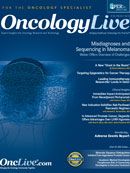A New "Giant in the Room:" Establishing Clinical Relevance in Small, Molecularly Defined Patient Subsets
A recognized recurring theme in many population-based cancer genetic studies is the highly provocative presence of a quite small percentage of tumors that possess specific molecular abnormalities unequivocally demonstrated to be "actionable," at least in one clinical setting.
Maurie Markman, MD
Editor-in-Chief of OncologyLive
Senior vice president for Clinical Affairs and National Director for Medical Oncology Cancer Treatment Centers of America, Eastern Regional Medical Center
A recognized recurring theme in many population-based cancer genetic studies is the highly provocative presence of a quite small percentage of tumors that possess specific molecular abnormalities unequivocally demonstrated to be “actionable,” at least in one clinical setting.
The term actionable has been used in various discussions to suggest that existing clinical data, or perhaps compelling preclinical data, support the potential clinical relevance of administering a particular targeted therapeutic (or class of therapeutics) in the presence of a given molecular abnormality.
The now classic observation that a similar molecular event characterizes the utility of imatinib in chronic myelogenous leukemia and gastrointestinal stromal tumors initiated an entirely new paradigm in cancer management, where it became recognized that “driver mutations” that define the natural history of a given cancer may be clinically relevant in two quite different cancer types and may even cross the divide between liquid and solid tumors.
Further, the benefits of examining the utility of a targeted antineoplastic drug in a different setting from the original approved indication— based on the presence of a specific molecular event previously revealed to define the activity in the approved indication—has also been well documented for HER2 overexpression in gastric cancer (following the earlier laboratory and clinical research efforts in breast cancer). However, the HER2 story becomes increasingly interesting and complex, since it is now recognized that the presence of overexpression of this surface marker defines both biological and clinical activity of HER2 inhibitors in a small percentage of both non-small cell lung cancers and even adult B-cell acute lymphoblastic leukemia (again, crossing the liquid tumor/solid tumor divide).
It is here that we begin to encounter a major and currently unresolved concern related to a determination of rational approaches required to demonstrate the utility of a given targeted therapeutic in a defined clinical scenario when the absolute number of patients available for such testing is realistically very limited. And, a critical extension of this question is: What level of evidence will be mandated by particular third-party payers of medical services before they agree to assume the financial burden associated with declaring a particular strategy to be an acceptable “standard of care” in a specific setting?
It is not difficult to point to a number of highly relevant circumstances based on recent reports in the peer-reviewed oncology literature where the question posed in the preceding paragraph requires far more than abstract consideration.
For example, reports have suggested that a mutation of ROS1, found in fewer than 2% of lung cancers, is responsive to the same agent (crizotinib) that has been approved for routine use in this malignancy when a different molecular abnormality (ALK rearrangement) is present.1 However, perhaps equally intriguing, this mutational event has been documented in a small percentage of gastric cancers.2 Therefore, the question to be addressed is: How can the overall clinical relevance associated with the administration of crizotinib in patients shown to have a ROS1 abnormality be evaluated?
While a small percentage of patients with lung cancer may be viewed by some as representing a relatively large total number of patients (considering the overall incidence of lung cancer within the population), this conclusion would surely not be rational when considering a potential role of the agent in gastric or other less common malignancies. Is it appropriate to conclude that a phase III trial or even a large phase II study should be absolutely required in each setting where possible clinical utility might realistically be proposed?
Finally, how should the situation be handled each time an additional molecular abnormality is found that potentially could be impacted by a commercially available antineoplastic? For example, Lennerz et al3 noted the biological and clinical activity of crizotinib in several patients with esophagogastric adenocarcinoma whose cancers possessed a MET amplification. Recognizing the tremendous cost associated with novel targeted therapeutics, it is essential that we determine the utility of this agent in a larger population to determine if such an approach should become a standard-of-care strategy in this very specific clinical setting. But how many patients, what type of trial, and what outcome, etc, will be required to make this determination?
So, in summary, the “giant in the room” issue that at some point in the near future must be addressed is how the community of interested parties— which includes patients and their families, the general public, those paying the healthcare bills, governmental regulators, clinical cancer investigators, and the pharmaceutical/biotech industry—can together develop a rational, highly efficient, and cost-effective strategy to answer these increasingly profoundly clinically relevant questions.
Maurie Markman, MD, editor-in-chief, is senior vice president for Clinical Affairs and national director for Medical Oncology at Cancer Treatment Centers of America. maurie.markman@ctca-hope.com
References
- Bergethon K, Shaw AT, Ou S-H I, et al. ROS1 rearrangements define a unique molecular class of lung cancers [published online ahead of print January 3, 2012]. J Clin Oncol. 2012; 30(8):863-870.
- Lee J, Lee SE, Kang SY, et al. Identification of ROS1 rearrangements in gastric adenocarcinoma [published online ahead of print February 7, 2013]. Cancer. 2013;119(9):1627-1635.
- Lennerz JK, Kwak EL, Ackerman A, et al. MET amplification identifies a small and aggressive subgroup of esophagogastric adenocarcinoma with evidence of responsiveness to crizotinib [published online ahead of print October 31, 2011]. J Clin Oncol. 2011; 29(36):4803-4810.




